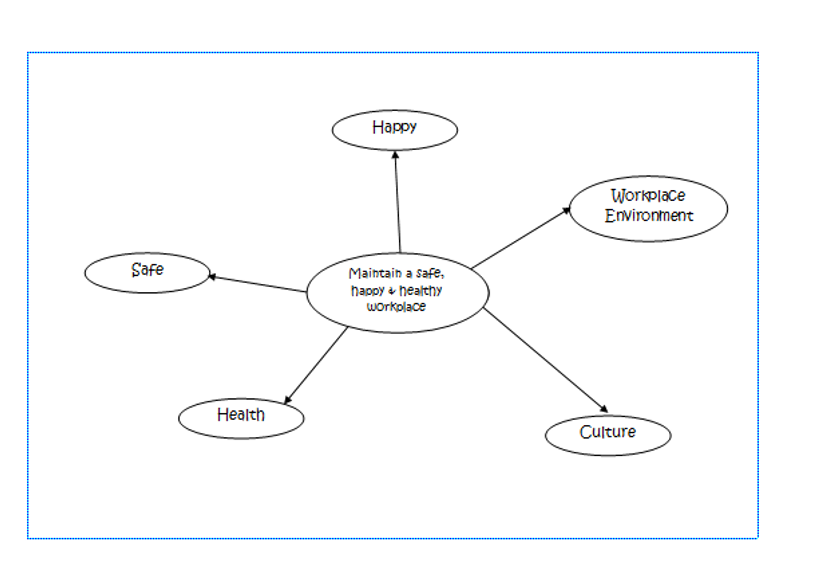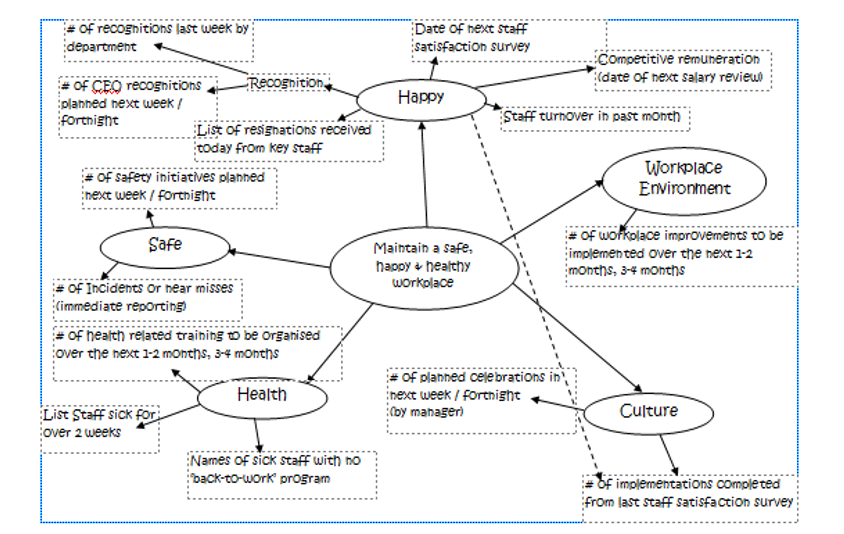Your cart is currently empty!
5 steps for teams to ascertain relevant measures from the organisation’s critical success factors
These steps are best undertaken in a two-day workshop.
Step 1: Train attendees to derive measures from the CSFs
When designing measures, you need a very structured process. You begin with the CSF that will be the easiest to measure, and then you ask the audience “What results you would expect to see if the critical success factor is working correctly”. You suggest to them to recycle the words used in the critical success factor name. I tend to aim for between four to five results.
Example: if we were to ascertain measures for the critical success factor “maintaining a safe, happy and healthy workplace” (see Exhibit 1), the results could be:
- staff happy with their work,
- nice workplace environment,
- workplace is safe at all times,
- healthy working conditions at all times,
- there is a positive “go for it” culture.
Every workgroup will have a slightly different mix of result wording. This does not matter as it is only the measures that will be recorded.
With each result, you ask the attendees, “What would good performance look like in this area?” Using their answers, ask them, “What measures would show this good performance best?” Then ask, “What would poor performance look like?” In response to their answers, ask them, “What measures would give advance warnings of this negative performance?”
For staff happy with their work we start ascertaining the likely measures. Which might include:
- Number of recognitions given last week by department
- Number of CEO recognitions planned for next week/next fortnight
- Number of incidents or near misses (immediate reporting)
The next stage is to mark the measures that are:
- Past measures with a P (Number of recognitions given last week by department)
- Current measures with a C (Number of incidents or near misses)
- Future measures with an F (Number of planned celebrations in next week / next fortnight)
Exhibit 1: Ascertaining measures from a critical success factor



Step 2: Show how to word measures properly
At this point we need to explain to staff what makes a useful measure:
- It should be free of abbreviations so that all employees will easily recognize the measure.
- It should describe what is being measured and not be a statement e.g., customer satisfaction survey (statement) number of initiatives implemented from the customer satisfaction survey (measure).
- There should be a focus on the exception and what is important e.g., Number of key customer complaints that have not been resolved within four hours (focusing on key customer complaints).
- It should encourage action in a timely manner (Performance indicator) or report how effectively teams have worked together (Result indicator).
Step 3: Achieve a mix of past, current, and future-looking measures
It is important for staff to learn to restate measures. There will be tendency to measure in the past as this is the easiest form of measurement. We now want them to measure also in the current and in the future time periods.
Current measures are measured 24/7 or daily, and future measures are the record of a future date when an action is to take place (e.g., date of next meeting with key customer, date of next product launch, date of next social interaction with key customers). Key result indicators and result indicators will all be past measures, whereas performance indicators and key performance indicators are now categorized as either past, current, or future measures. You will find that most of the KPIs in your organization will fit into the current or future categories.
Step 4: Removal of duplicated measures
Before the workshop ends, all workgroups are asked to review the measures output. The measures are printed out from the database by critical success factor and placed on a wall for review. The attendees are asked to view the lists on the wall and delete all duplicated measures and edit any unclear measure names, Exhibit 2 .
Exhibit 2: Staff looking for duplicated measures.

Step 5: Introduce a moratorium on measures being developed outside the KPI project.
Every organization is likely to have a number of performance measures in place, even if they are not called KPIs. These existing measures need to be reviewed to fit them within the new four-tiered structure of performance measures (KRIs, RIs, PIs, KPIs). There must be a moratorium on measures being developed outside of the KPI project.
To get my latest work
Buy my implementation guides and accompanying electronic media to get you started.
How to implement winning KPIs (180 page Whitepaper + electronic templates)
Finding your Organization’s Critical Success Factors – implementation guide (Whitepaper 115 pages+ electronic templates)
Database of Measures and Associated Success Factors 4th Edition